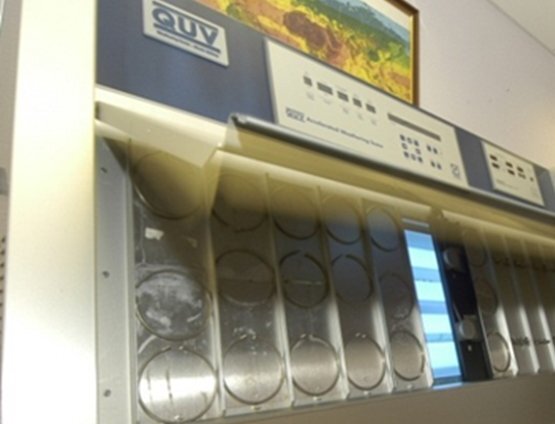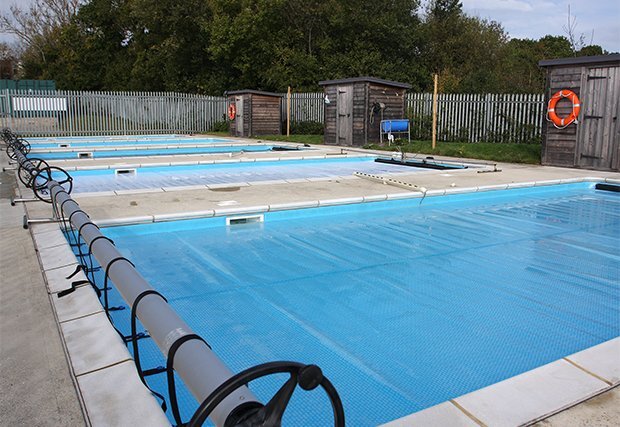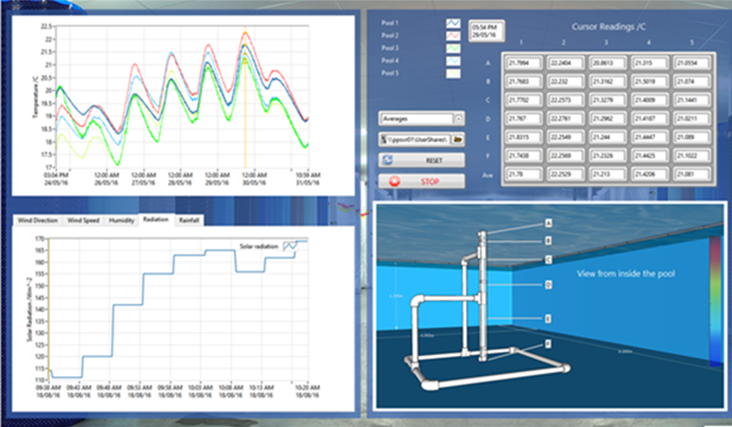Testing and Development of GeoBubble™ materials
In the pages of this website we talk at length about what a GeoBubble™ pool cover can do for your pool, the differences in cover types, and the particular qualities of our High-Performance Guard materials. Everything that we say about the materials is backed up by rigorous testing – much of which is conducted on site at our bespoke testing facility.
On Site Testing
GeoBubble™ materials are developed, manufactured and tested at Plastipack HQ, where we have a dedicated Research and Development team, supported by placement students from The University of Surrey. On site, we have a bespoke testing facility consisting of five identical swimming pools, enabling the team to conduct comparative testing of different cover materials. This allows us to test the effectiveness of any products in development, as well as to perform quality control on products already in the market.
We work with the leading additive suppliers in Europe to create bespoke additive packages for our materials, with new products spending years in development to ensure that we’re manufacturing the best possible product for pool owners. For example, the award winning EnergyGuard™ Selective Transmission spent two years in development before its launch to the market.

In order to determine the benefits of covering an outdoor pool with our GeoBubble™ materials, particularly in relation to changes in water temperature, test pools are covered with a selection of our GeoBubble™ covers, with one pool left uncovered to act as a control. Details of these tests can be found in the box to the right.
Other testing has been conducted to determine the effects of GeoBubble™ products with respect to controlling evaporation from the surface of a pool. Here, a test was devised whereby two unheated tanks, with a surface area of 1m x 1.5m were each filled to a depth of 0.435m. One tank was subsequently covered with a 400 Grade standard GeoBubble™ product, and the other left uncovered before being positioned outdoors in direct sunlight. This test was done in July 2009 in the South East of the United Kingdom.
At conclusion of the test the water depths of both tanks were measured and used to calculate the water remaining in each tank.
Percentage water lost by evaporation was subsequently calculated for comparison.
Read the results of this testing in our Light Blue Case Study.
Lifespan testing
Alongside the test pools, we also have a QUV Accelerated Weathering testing machine on site. This machine allows us to simulate outdoor weathering, by reproducing the damage caused by sunlight, rain and dew. We also add an additional high concentration chlorine treatment to replicate a swimming pool environment. Repeated testing with this tool helps provide us with an expected lifespan of the materials.

The testing process

Our state-of-the-art testing centre consists of five identical outdoor test pools in Hastings, UK. All test pools at our facility are unheated and measure 8m X 4m with a 1.3m depth, having been designed to be representative of an average sized, privately owned pool. The pools have a volume of 41,600L and each contain an array of 6 type-T thermocouples at their centre, continually logging water temperature at incremental depths and calculating average water temperature.
Logging and compilation of the temperature data is completely autonomous, maximising accuracy and reproducibility of results. A bespoke computer programme was developed to achieve this and was coded using specialist LabView™ software. This programme was designed by Plastipack engineers in close collaboration with experts at the University of Surrey.

Each pool is serviced by its own 0.75hp filtration pump running for 8 hours each day (6 hours during the day, 2 at overnight), a pattern commonly accepted as best practice for filtration efficiency within the industry. During testing, water samples are taken every other day to ensure that chemical concentrations remained within the accepted industry standard pH, free chlorine and combined chlorine concentrations of the pool water were logged manually using a specialist photometry device. Any chemical additions required to restore and rebalance water chemistry to within the acceptable limits are recorded. These records are then used to build a detailed dosing regimen for each test pool to allow for comparison of ‘chemical consumption’.
Anecdotal Evidence
We also invite feedback from customers to gain anecdotal evidence from pool users to back up our claims regarding our covers’ performance on domestic pools.
These testimonials come from anywhere from Kent to California and provide us with valuable insight into the performance of our materials. One such testimonial was provided by Fred in California who was able to closely monitor the temperature of his CoolGuard™ covered pool and saw excellent results as shown in this case study.
To see the results of the onsite testing, take a look at the Case Studies on our Downloads page.
Do you use a GeoBubble™ cover on your pool? Tell us about it!
Send your reviews to us on Twitter @Plastipack_Ltd or email us info@geobubblepoolcovers.com.













